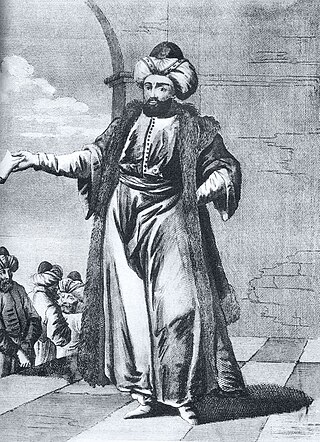
The Regency of Algiers was a largely independent early modern Ottoman tributary state on the Barbary Coast of North Africa between 1516 and 1830 established by the corsair brothers Aruj and Hayreddin Barbarossa, also known as Oruç and Khayr ad-Din. The Regency was an infamous and formidable pirate base that plundered and waged maritime holy war on European Christian powers. Ottoman regents ruled it as heads of a military oligarchy of janissaries and corsairs.

The French conquest of Algeria took place between 1830 and 1903. In 1827, an argument between Hussein Dey, the ruler of the Regency of Algiers, and the French consul escalated into a blockade, following which the July Monarchy of France invaded and quickly seized Algiers in 1830, and seized other coastal communities. Amid internal political strife in France, decisions were repeatedly taken to retain control of the territory, and additional military forces were brought in over the following years to quell resistance in the interior of the country.

Mohamed Bey El Mouradi was a Muradid leader and Bey of Tunis from 1675 until his death in 1696. He was the eldest son of Murad II Bey.
The Battle of Chelif or Battle of Djidouia took place on 28 April 1701 on the banks of the Chelif River. It was fought between the armies of the Alaouite Sultan Ismail Ibn Sharif and those of the Regency of Algiers commanded by the Bey of Mascara, Mustapha Bouchelaghem. It took place in the context of an attempt by the Alaouites to conquer the west of the Regency of Algiers, coordinated with an offensive by Tunis on the east of the Regency of Algiers in 1700 and 1701.

Baba Ali Chaouch, also known as Ali Soukali, or simply Ali I, was a ruler of the Deylik of Algiers from 1710 to 1718. He was the first dey of Algiers to be invested with the title of dey-pacha. The Sultan Ahmed III had Ali Chaouch's envoy given the caftan and the three tails, a sign of the dignity of a "pasha". This title was attributed to all his successors until 1830.

The Beylik of Constantine, Beylik of the Sunrise or Beylik of the East as was its official designation, was one of the three Beyliks of the Regency of Algiers . The region liberated itself from the Hafsid Emirate of Béjaïa in the early 16th century, and constituted itself around Constantine in the mid to late 16th century. The Beylik collapsed in the 1837 siege of Constantine during the French conquest of Algeria. The Constantine department was formed upon the bases of the Beylik in 1848.

The Tunisian–Algerian war of 1694 was a conflict between the Deylik of Algiers, and the Regency of Tunis.
The Maghrebi war (1699–1702) was a conflict involving a Tunisian, Tripolitanian, and Moroccan coalition, and the Deylik of Algiers. It was an important milestone in the further weakening of the already fragile Ottoman grip over the Maghreb, as both sides utterly ignored the Ottoman sultan's pleas to sign a peace treaty. This war also led to the renewal of the Muradid infighting, which would later lead to the establishment of the Beylik of Tunis, and the Husainid dynasty in 1705.
The siege of Tunis was a siege fought in 1694, between the Deylik of Algiers, and Muradid Tunis, during the Tunisian-Algerian War of 1694.
The Constantine campaign was launched by Bey of Tunis Murad III Bey in 1699 to capture the Beylik of Constantine, situated in the east of the Deylik of Algiers.
The Capture of Tunis occurred in 1735 when the Dey of Algiers sent an invasion force to Tunis in order to install Ali Pasha as the Bey.
The Capture of Tunis was a military operation led by the Bey of Constantine during which he seized Tunis and made the Beylik of Tunis a tributary of Algiers.

The Tunisian–Algerian War of 1807 was a conflict between the Beylik of Tunis and the Deylik of Algiers. The war led to the emancipation of Tunisia from any sort of Algerian influence, and the ending of the tribute paid by Tunisia to Algeria since 1756.
The Tunisian–Algerian War of 1705 was a conflict between the Regency of Algiers and the Regency of Tunis.

The Tunisian–Algerian War of 1813 was a conflict between the Regency of Algiers and the Regency of Tunis.
Hadj Hassen-Chaouch or Hadj Hassen-Chaouch was the 6th ruler and Dey of Algiers. He ruled just a couple of months between 1698 and 1700.
Hadj Mustapha was the 7th ruler and Dey of Algiers. He ruled five years after his predecessor Hadj Chaouch.
Battle of Tunis (1705) Was a conflict between Algiers and Tunis
Algerian Invasion of Tunis (1705) was a conflict between Algiers and Tunis. The Algerians attacked tunis to finish the Husinid dynasty but they lost the war and went back to Algeria.
The Siege of Tunis (1705) was a Battle between the Regency of Algiers and the Regency of Tunis.







